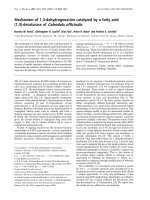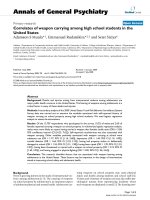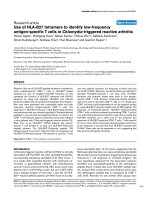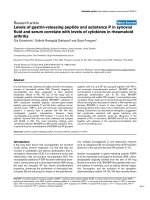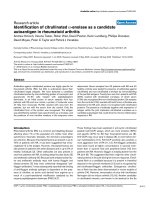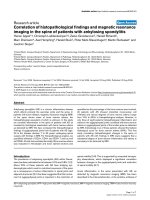Báo cáo y học: " Mechanism of cigarette smoke condensate-induced acute inflammatory response in human bronchial epithelial cells" docx
Bạn đang xem bản rút gọn của tài liệu. Xem và tải ngay bản đầy đủ của tài liệu tại đây (416.17 KB, 8 trang )
Available online />Page 1 of 8
(page number not for citation purposes)
Respiratory Research
Vol 3 No 1
/>Hellermann
et al.
Research article
Mechanism of cigarette smoke condensate-induced acute
inflammatory response in human bronchial epithelial cells
Gary R Hellermann, Szilvia B Nagy, Xiaoyuan Kong, Richard F Lockey and Shyam S Mohapatra
Division of Allergy and Immunology and the Joy McCann Culverhouse Airway Disease Center, Department of Internal Medicine, University of South
Florida College of Medicine and VA Hospital, Tampa, Florida, 33612, USA
Correspondence: Shyam S Mohapatra -
Abstract
Background: To demonstrate the involvement of tobacco smoking in the pathophysiology of lung
disease, the responses of pulmonary epithelial cells to cigarette smoke condensate (CSC) — the
particulate fraction of tobacco smoke — were examined.
Methods: The human alveolar epithelial cell line A549 and normal human bronchial epithelial cells
(NHBEs) were exposed to 0.4 µg/ml CSC, a concentration that resulted in >90% cell survival and
<5% apoptosis. Changes in gene expression and signaling responses were determined by RT-PCR,
western blotting and immunocytofluorescence.
Results: NHBEs exposed to CSC showed increased expression of the inflammatory mediators sICAM-
1, IL-1β, IL-8 and GM-CSF, as determined by RT-PCR. CSC-induced IL-1β expression was reduced
by PD98059, a blocker of mitogen-actived protein kinase (MAPK) kinase (MEK), and by PDTC, a NFκB
inhibitor. Analysis of intracellular signaling pathways, using antibodies specific for phosphorylated
MAPKs (extracellular signal-regulated kinase [ERK]-1/2), demonstrated an increased level of
phosphorylated ERK1/2 with increasing CSC concentration. Nuclear localization of phosphorylated
ERK1/2 was seen within 30 min of CSC exposure and was inhibited by PD98059. Increased
phosphorylation and nuclear translocation of IκB was also seen after CSC exposure. A549 cells
transfected with a luciferase reporter plasmid containing a NFκB-inducible promoter sequence and
exposed to CSC (0.4 µg/ml) or TNF-α (50 ng/ml) had an increased reporter activity of approximately
2-fold for CSC and 3.5-fold for TNF-α relative to untreated controls.
Conclusion: The acute phase response of NHBEs to cigarette smoke involves activation of both MAPK
and NFκB.
Keywords: bronchial, cigarette, MAPK, NF-kappaB, signal transduction
Introduction
The association of inhaled particulate pollution and ciga-
rette smoking with pulmonary disease, such as chronic ob-
structive pulmonary disease, is well documented [1], but
the specific early responses of lung epithelial cells to toxic
substances in particulates — that predispose the cells to
disease — have not been elucidated. Cigarette smoke has
also been considered a major player in the pathogenesis of
asthma and as a trigger for acute symptoms [2]. Exposure
to cigarette smoke activates an inflammatory cascade in
the airway epithelium resulting in the production of a
number of potent cytokines and chemokines, with accom-
panying damage to the lung epithelium, increased permea-
bility, and recruitment of macrophages and neutrophils to
the airway [3]. Even brief exposure to cigarette smoke has
been shown to increase expression of IL-8 in primary cul-
tures of human bronchial epithelial cells (HBEs) in the pres-
ence of dust mite allergen [4]. Increased release of the
chemokine IL-8 has also been shown for cultured HBEs ex-
posed to cigarette smoke extract (CSE) [5,6] and diesel ex-
haust particles [7]. However, the precise molecular events
Received: 6 December 2001
Revisions requested: 12 February 2002
Revisions received: 11 April 2002
Accepted: 8 May 2002
Published: 10 July 2002
Respir Res 2002, 3:22
© 2002 Hellerman et al., licensee BioMed Central Ltd
(Print ISSN 1465-9921; Online ISSN 1465-993X)
Respiratory Research Vol 3 No 1 Hellermann et al.
Page 2 of 8
(page number not for citation purposes)
that bring about these intracellular changes and acute in-
flammation in lung epithelial cells are not well understood.
Upregulation of cytokine gene expression in epithelial cells
has been linked to activation of specific signaling path-
ways. Involvement of the mitogen-activated protein kinase
(MAPK) pathway, extracellular signal-regulated protein ki-
nase (ERK)-1/2 (p44/p42), in cytokine regulation has been
demonstrated in HBEs exposed to diesel exhaust particles
[7] but not to cigarette smoke. NF
κB is a ubiquitous tran-
scription factor involved in regulating inflammatory re-
sponses, and its targets include several of the genes
encoding cytokines and chemokines. The activation of
NF
κB by oxidative stress, inflammatory cytokines such as
IL-1
β and by TNF-α has been studied in depth [8], but
much less is known about the effects of cigarette smoke on
NF
κB activation.
The purpose of this study was to gain insight into the mech-
anism of inflammation induced by cigarette smoke, specifi-
cally the acute response to smoke. The human alveolar
epithelial cell line A549 and normal human bronchial epi-
thelial cells (NHBEs) were exposed to the particulate frac-
tion of cigarette smoke (cigarette smoke condensate;
CSC) and examined for the production of proinflammatory
cytokines and activation of MAPK and NF
κB. The results
demonstrate that the acute phase response of pulmonary
epithelial cells to cigarette smoke involves activation of
ERK1/2 and NF
κB
Materials and methods
Reagents
RPMI 1640, penicillin, streptomycin, fungizone, and
trypsin/EDTA were obtained from Cellgro (Herndon, VA,
USA). Fetal bovine serum was from Atlanta Biochemicals
(Atlanta, GA, USA). The culture medium (BEGM), growth
factors, trypsin, trypsin neutralizing solution, and Hanks'
balanced salt solution for growing and treating primary hu-
man epithelial cells were purchased from Clonetics (San
Diego, CA, USA. CSC was purchased from Murty Pharma-
ceuticals (Lexington, KY, USA) and was prepared using a
Phipps-Bird 20-channel smoking machine designed for
FTC testing. The particulate matter from Kentucky standard
cigarettes (1R3F; University of Kentucky, KY, USA) was
collected on Cambridge glass fibre filters and the amount
obtained determined by weight increase of the filter. CSC
was prepared by dissolving the collected smoke particu-
lates in dimethyl sulfoxide (DMSO) to yield a 4% solution
(w/v). The average yield of CSC was 26.1 mg/cigarette.
The CSC was diluted into DMSO and aliquots were kept at
-80
°C. Oligonucleotide primers for PCR were synthesized
by Operon Technologies (Alameda, CA, USA). Taq
polymerase, deoxynucleotide triphosphates and Taq buffer
were from Promega (Madison, WI, USA). Anti-ERK1/2
(p44/p42) polyclonal antibody, anti-phosphorylated ERK1/
2 polyclonal antibody, and horseradish peroxidase (HRP)-
conjugated goat anti-rabbit IgG were purchased from New
England Biolabs (Beverly, MA, USA). Anti-phosphorylated
I
κB-α polyclonal antibody, IκB monoclonal antibody and
chemiluminescent detection reagents were from Cell Sign-
aling Technology (Beverly, MA, USA).
Cell culture
The human alveolar epithelial cell line A549 (ATCC, Rock-
ville, MD, USA) was grown in RPMI plus 10% fetal bovine
serum, 100 U/ml penicillin, 100 U/ml streptomycin, and
250 ng/ml amphotericin-B in an atmosphere of 5% carbon
dioxide and 95% air at 37
°C. Primary cultures of NHBEs
(Clonetics, San Diego, CA, USA) were obtained at second
passage and cultured according to the manufacturer's in-
structions using the media and growth factors supplied
with the cells. The cells were seeded into 12-well culture
plates at 10
5
cells per well and used between passages
three and seven.
Exposure of epithelial cells to cigarette smoke conden-
sate
Cultures of A549 cells or NHBEs were grown to 50–75%
confluence, then incubated with serum-deficient media for
4 hours before exposure to CSC. Treatment with CSC, at
a final concentration of 0.4
µg/ml in 0.5% DMSO, was car-
ried out in modified Eagle's medium (MEM) containing Ear-
le's salts at 37
°C for 30 min to 5 hours. Control cells were
treated with the same concentration of DMSO without
CSC. For CSC dose-response experiments, cells were in-
cubated for 30 min at 37
°C with concentrations of CSC
ranging from 0.004 to 20
µg/ml in 0.5% DMSO. Cell viabil-
ity after CSC treatment was determined using the trypan
blue dye exclusion test and was compared to viability of un-
treated control cells.
TUNEL assay
The induction of apoptosis was determined by means of
the TUNEL (deoxynucleotidyl transferase-mediated dUTP
nick end labeling) assay using a kit supplied by Promega
(Madison, WI, USA). Cultures of A549 cells or NHBEs
were grown on 8-well slides and treated with CSC as de-
scribed above, fixed with 4% paraformaldehyde for 15 min
at room temperature, then examined by fluorescent micros-
copy. Nuclei were counterstained by the addition of 4',6-di-
amidino-2-phenylindole dihydrochloride (DAPI; Molecular
Probes, Eugene, OR, USA) to the mounting medium. The
percentage of apoptotic cells was determined by counting
green fluorescent nuclei relative to the total number of
DAPI-positive nuclei.
Reverse-transcriptase PCR
A549 cells or NHBEs were grown to approximately 75%
confluence in 12-well plates, treated with various concen-
trations of CSC in 0.5% DMSO, and total RNA was isolat-
Available online />Page 3 of 8
(page number not for citation purposes)
ed using RNeasy method (Qiagen, Valencia, CA, USA).
RNA (1
µg) was converted to cDNA in a 50 µl reaction con-
taining 1 U of avian myeloblastosis virus reverse tran-
scriptase (New England Biolabs, Beverly, MA, USA), 1 mM
dNTP's, and 10
µg/ml random hexamer primers in 1× re-
verse transcriptase buffer at 42
°C for 50 min; the reaction
was terminated by heating to 90
°C for 10 min. The result-
ing cDNA was used as template for PCR amplification us-
ing the primer pairs (Operon Technologies, Alameda, CA,
USA) listed in Table 1. As a loading control parallel PCR re-
actions were carried out using a primer pair for human
GAPDH (see Table 1). PCR products were separated on
agarose gels, the ethidium bromide-stained bands were
digitally photographed using a ChemImager 4400 (Alpha
Inotech, San Leandro, CA, USA) and scanned using the
AphaEase version 5.5 densitometry program. The experi-
mental values were normalized to the corresponding GAP-
DH value and expressed as relative intensity.
Western blotting and immunocytochemistry
A549 cells or NHBEs were treated with CSC as described
above and whole-cell protein extracts were prepared by
scraping cells into lysis buffer containing 20 mM Tris-HCl
(pH 8.0), 1 mM EDTA, 1 mM sodium orthovanadate, 1 mM
sodium fluoride, 1
µg/ml each of leupeptin and pepstatin,
and 1
µM PMSF. Cell lysis was achieved by sonicating the
suspension on ice with three 10-second bursts at a power
setting of 2 mW (Sonic Dismembrator, Fisher Scientific
Co., Atlanta, GA, USA). Lysates were clarified by centrifu-
gation at 10,000
× g for 30 min at 4°C and the protein con-
centration of the whole-cell extracts was determined by the
bicinchoninic protein assay (Pierce Biochemical Co., Rock-
ford, IL, USA). Aliquots of 10
µg of protein were separated
by SDS-PAGE and electroblotted to nitrocellulose. The fil-
ters were blocked with 2% nonfat dry milk in 10 mM Tris-
HCl (pH 8.0), 0.15 M sodium chloride, 0.2% Tween-20
(TBST) then incubated with primary antibody (1:1000 dilu-
tion) for 2 hours at room temperature. After washing in Tris-
buffered saline with tween 20 (TBST), blots were incubat-
ed for one hour at room temperature with HRP-conjugated
secondary antibody, washed again and detected by chemi-
luminescence. The protein bands were quantified by densi-
tometry as described above. For immunocytochemistry,
NHBEs grown on 8-well chamber slides were exposed to
CSC at a concentration of 0.4
µg/ml for 30 min. Cells were
fixed with 4% paraformaldehyde, blocked with BSA, immu-
nostained using anti-phosphorylated ERK1/2, and visual-
ized using HRP-conjugated secondary antibody and
bisbenzamidine substrate.
Transfection with NF
κ
B-luciferase reporter constructs
and assay for gene expression
A549 cells were grown to 50–80% confluence on 12-well
plates and transfected with the Mercury pathway profiling
system vector, pNF
κB-TA-Luc (Clontech, Palo Alto, CA,
USA), using lipofectamine (Gibco/BRL, Rockville, MD,
USA) and used according to the manufacturer's recom-
mendations. Cells were transfected using lipofectamine
from Bibco/BRL (Rockville, MD). The plasmid, pVAX-LacZ,
(Clontech, Palo Alto, CA, USA) was used as transfection
control.
DNA/lipofectamine complexes were allowed to form for 30
min at room temperature in RPMI (without antibiotics) con-
taining 1
µg of reporter plasmid, 20 ng of pVAX-LacZ for
monitoring transfection efficiency, and 10
µg of lipo-
fectamine. Cells were transfected for 18 h. Prior to CSC
challenge, the transfected cells were preincubated for 4
hours in minimal Eagle's medium with Earle's salts to re-
move serum factors. Assays were done in triplicate and
consisted of untreated controls, treatment with 50 ng/ml
TNF-
α and treatment with 0.4 µg/ml CSC. After treat-
ments, the cells were lysed by addition of cell lysis buffer as
supplied in the luciferase assay kit from Clontech, scraped
from the wells and centrifuged 1 min at 12,000
× g. Aliq-
uots of 20
µl of each lysate were transferred to flat-bot-
tomed, white microtiter plates (Dynex, Chantilly, VA, USA)
and read on a Dynex MLX plate reader in flash mode. The
transfection efficiency was normalized by determining
β-ga-
lactosidase activity in the lysates from the cotransfected
pLacZ plasmid.
Statistical Analysis
All values are expressed as mean ± standard error of the
mean (SEM). Comparisons of experimental values for
CSC-treated cells to untreated controls were done by anal-
ysis of variance (ANOVA). Probability values of < 0.05
were considered significant.
Table 1
Primer pairs used for PCR of cDNA from CSC-treated NHBEs
and A549 cells
Name Forward primer sequence
(5'
→3')
Reverse primer sequence
(5'→3')
SICAM-1 Atggctcccagcagcccc cacctggcagcgtagggt
Il-1b Gacctggacctctgccctctg aggtattttgtcattactttc
RANTES tgaaggtctccgcggcacgcct ctagctcatctccaaagagttg
IL-6 Aactccttctccacaagcg tggactgcaggaactcctt
IL-8 Atttctgcagctctgtgtaa tcctgtggcatccacgaaact
GM-CSF Atgtggctgcagagcctgc tcactcctggactggctcc
GAPDH atggggaaggtgaaggtcgga gagatgatgacccttttggc
Respiratory Research Vol 3 No 1 Hellermann et al.
Page 4 of 8
(page number not for citation purposes)
Results
Effects of cigarette smoke condensate on cell viability
and apoptosis
To determine the effects of CSC on cell viability, A549 cells
and NHBEs were exposed to increasing concentrations of
CSC for 30 min then examined using the trypan blue dye-
exclusion test (Fig. 1A). Maximum toxicity for A549 at the
highest concentration of CSC (20
µg/ml) was 15%. At low-
er CSC concentrations (<0.1
µg/ml), survival was greater
than 90% for both A549 cells and NHBEs. Induction of ap-
optosis by CSC was determined in A549 cells and NHBEs
by using the TUNEL assay and confirmed by DNA fragmen-
tation analysis (data not shown). NHBEs showed 5 to 10%
apoptosis at moderate doses of CSC; A549 cells showed
less than 5% apoptosis (Fig. 1B). However, with increasing
concentration of CSC, NHBEs showed as high as 20% ap-
optosis, while A549 cells remained unchanged.
Changes in expression of specific cytokines and chem-
okines after exposure to cigarette smoke condensate
To characterize the response of epithelial cells to CSC we
determined the changes in message levels for a group of
cytokines, chemokines and cell-adhesion molecules. Total
RNA isolated from NHBEs following exposure to CSC was
subjected to RT-PCR, and the results are shown in Fig. 2.
IL-1
β was induced to a level 9.5 times that of untreated
controls, while the expression of IL-8 and GM-CSF was in-
creased 2.7-fold and 2.2-fold, respectively. Expression of
the adhesion molecule ICAM-1 was found to be approxi-
mately 1.6 times the level of control. IL-6 and the chemok-
ine RANTES were elevated slightly (Fig. 2). This pattern of
enhancement of proinflammatory mediator expression im-
plies that specific effector compounds are present in CSC.
Involvement of the MAPK pathway in response to ciga-
rette smoke condensate
To examine if CSC-upregulation of cytokine production in-
volves activation of MAPKs we examined CSC-treated NH-
BEs for specific phosphorylated species. Fig. 3A shows
the results of a western blot of whole-cell extracts from NH-
BEs exposed to increasing concentrations of CSC and
probed for phosphorylated ERK1/2, the activated form of
ERK1/2. Band densities on the film were measured and the
protein loading variations were adjusted by normalizing to
the levels of non-phosphorylated ERK1/2. The level of
ERK1/2 phosphorylation increased rapidly with increasing
exposure to CSC, to a maximum of nearly twice the control.
To confirm the results of immunoblot detection of phospho-
rylated ERK1/2, NHBEs were exposed to 0.4
µg/ml CSC
for 30 min, then fixed and stained for phosphorylated
Figure 1
Effect of CSC on viability and apoptosis in A549 cells and NHBEs. Cells were grown to about 70% confluence in 12-well plates (Panel A, viability)
or 8-well chamber slides (Panel B, apoptosis). Cells were exposed to the indicated concentration of CSC for 30 min then rinsed with PBS and proc-
essed for each assay. Viability was determined by trypan blue vital staining and expressed as percent of total cells. Apoptosis was measured by flu-
orescent TUNEL assay and is expressed as the percent of cells exhibiting apoptosis relative to the total number of cells. The values are the mean
±
SEM for n = 3. ( ᭹ A549; Њ NHBE) CSC = cigarette smoke condensate; NBHE = normal human bronchial epithelial cell; PBS = phosphate-
buffered saline; SEM = standard error of the mean; TUNEL = deoxynucleotidyl transferase-mediated dUTP nick end labeling
Available online />Page 5 of 8
(page number not for citation purposes)
ERK1/2. Exposure to CSC caused a marked increase in
nuclear staining of cells with phosphorylated ERK1/2 anti-
bodies (Fig 3B). This nuclear localization and phosphorylat-
ed ERK1/2 staining was largely blocked by pretreating with
the MEK inhibitor PD98059. The CSC-induced increase in
IL-1
β expression was also reduced by treatment of the cells
with PD98059 or the NF
κB inhibitor, PDTC (Fig. 3C).
These results suggest that CSC activates ERK1/2 in these
cells within 30 min.
Cigarette smoke condensate treatment induces rapid ac-
tivation of the NF
κ
B pathway
To determine whether upregulation of cytokine production
by CSC involved activation of NF
κB, we examined CSC-
treated epithelial cells for phosphorylation of the inhibitor of
NF
κB (IκB). NHBEs were treated with increasing concen-
trations of CSC and whole-cell extracts were immunoblot-
ted for phosphorylated I
κB. Activation of NFκB involves the
increased phosphorylation and proteolytic degradation of
I
κB. Treatment of cells with increasing concentrations of
CSC resulted in an initial rise in phosphorylated I
κB levels
followed by a decrease (Fig. 4A). Protein bands were quan-
titated by densitometry on the film and the phosphorylated
I
κB densities were normalized to the levels of IκB. NHBEs
exposed to CSC also showed an increase in nuclear stain-
ing of phosphorylated I
κB as detected by immunocyto-
chemical staining using an antibody to phosphorylated I
κB
(Fig. 4B).
Effect of cigarette smoke condensate on transcriptional
activation of luciferase reporter construct
CSC appears to activate NFκB, which should result in tran-
scriptional activation of NF
κB-inducible genes. Therefore,
A549 cells were transfected with a luciferase reporter plas-
mid containing a promoter sequence that bound NF
κB and
luciferase activity was measured after challenge with CSC.
Treatment with 0.4
µg/ml CSC for 30 min resulted in sig-
nificant enhancement of luciferase reporter expression
compared to control (Fig. 4C), indicating activation of
NF
κB. TNF-α used as a positive control also activated luci-
ferase gene expression with the same plasmid system. Ex-
posure of cells transfected with the reporter plasmid to
increasing doses of CSC showed NF
κB expression peak-
ing at a CSC concentration between 1 and 4
µg/ml (Fig.
4D).
Discussion
The complex changes in lung function, morphology, and
gene expression caused by compounds in cigarette smoke
involve a combination of direct and indirect effects on cells,
but principally center around an increase in airway inflam-
mation as a result of cigarette smoking. The results of our
studies demonstrate that the mechanism underlying these
acute inflammatory events involves activation of specific
signaling pathways such as MAPK (ERK1/2) and NF
κB,
leading to the release of proinflammatory cytokines.
One of the important observations of this study is the effect
of CSC on NHBEs. Even at a concentration of 0.4
µg/ml,
which does not induce significant changes in the viability of
these cells, CSC induced increases in expression of sever-
al cytokines at the mRNA level. IL-1
β, which was signifi-
cantly upregulated in NHBEs following CSC exposure, has
been shown to be important for activation of IL-8 [6] and
ICAM-1 [4]. This is also consistent with the report that ep-
ithelial cells regulate inflammatory events by secreting cy-
tokines and chemokines such as IL-1
β, IL-8, GM-CSF,
TNF-
α, and sICAM-1 [2]. These paracrine effectors can
then produce further primary local inflammation or amplify
the effects of previously activated macrophages, eosi-
nophils, mast cells, or lymphocytes. A notable finding from
our study is that exposure of NHBEs to CSC elicits the syn-
thesis and release of a pattern of mediators similar to that
seen in A549 cells in response to CSC. These results imply
that neoplastic cells and normal cells respond to CSC in a
similar manner.
Cigarette smoke has been shown by others to induce a
synthesis of glutathione and gamma-glutamylcysteine that
was associated with transcription factor AP-1 or an AP-1-
like response element [9]. Although MAPKs and NF
κB
have been implicated in the upregulation of proinflammato-
ry cytokines, the role of these pathways in normal human
pulmonary epithelial cells in response to CSC has not been
Figure 2
Effect of CSC treatment on proinflammatory gene expression. NHBEs
were exposed to CSC at a concentration of 0.4
µg/ml for 30 min at
37
°C. Total RNA was isolated and specific gene expression measured
by RT-PCR assay. Target gene expression levels were normalized to
the level of GAPDH expression in each reaction and expressed as fold
change relative to control. The values are means
± SEM for n = 3. Sig-
nificant differences at P < 0.05 are indicated by *. CSC = cigarette
smoke condensate; NBHE = normal human bronchial epithelial cell;
RT-PCR = reverse transcriptase-polymerase chain reaction; SEM =
standard error of the mean
Respiratory Research Vol 3 No 1 Hellermann et al.
Page 6 of 8
(page number not for citation purposes)
investigated. The results of our study implicate the ERK1/2
(p42/44) MAPK pathway as a key element in this inflamma-
tory response, an association that has not heretofore been
reported in normal human pulmonary epithelial cells. A sig-
nificant finding of this study is that MAPKs such as ERK1/
2 (p44/p42) are consistently activated in NHBEs. Howev-
er, upon exposure to CSC, the magnitude of phosphoryla-
tion increases. The finding that IL-1
β expression and MAPK
activation are concomitantly increased by CSC exposure
and inhibited by PD98059 is consistent with the report that
MAPKs activate expression of IL-1
β genes [10]. Although
the control of cytokine expression was not investigated,
ERK1/2 has been reported to upregulate IL-8, TNF
α, and
sICAM-1 expression [11–13]. Interestingly, phosphoryla-
tion of p38 MAPK could not be detected in these cells (da-
ta not shown). Activation of p38 has been reported in
epithelial cells in conjunction with CSC-induced stress re-
sponse [14]. The activation of ERK1/2 appears to be CSC-
specific as it was not phosphorylated by respiratory syncy-
tial virus infection (San Juan and Mohapatra, unpublished
data) Thus, activation of different MAPKs appears to be
specific to cell lines and environmental stimuli.
Another major finding of our studies is that CSC induces
activation of NF
κB, a central mediator of proinflammatory
responses, which is activated under oxidative stress and
upon injury to cells [15]. The reporter gene analysis indi-
cates the potential for CSC exposure to activate any gene
having NF
κB binding sites. This is consistent with results of
TransFac
T
analysis of promoter elements of IL-1, IL-8, IL-6,
and ICAM-1, all of which possess NF
κB binding sites in
their promoters (data not shown). While our results demon-
strate that the acute response to CSC involves a concom-
itant activation of the MAPK and NF
κB pathways, the
physiological mechanism remains to be elucidated. Several
studies have pointed to reactive oxygen species as the me-
Figure 3
CSC-induced phosphorylation of ERK1/2 and IL-1β expression. (A) CSC induces ERK1/2 phosphorylation. NHBEs were incubated with the indi-
cated concentrations of CSC for 30 min at 37°C. Whole-cell protein extracts were prepared from cell lysates, aliquots of 10 µg of protein were sep-
arated by SDS-PAGE, transferred to nitrocellulose and probed with an antibody to phosphorylated ERK1/2. Blots were then stripped and reprobed
for ERK1/2. The band intensities were determined by densitometry and the fold-change relative to control was plotted as means
± SEM. (B) Nuclear
localization of phosphorylated ERK1/2 in NHBEs. Cells were incubated with 0.4
µg/ml CSC for 30 min at 37°C, then fixed with paraformaldehyde
and probed with antibody to phosphorylated ERK1/2. Visualization was achieved by incubating the cells with HRP-conjugated secondary antibody
and bisbenzamidine substrate. Cells were treated with vehicle alone (Control), with CSC (CSC), or with CSC and the MEK inhibitor, PD98059 (20
µM) (CSC + PD98059). (C) Inhibition of ERK1/2 or IκB phosphorylation attenuates IL-1β expression in A549. Cells were treated with 50 µg/ml
PD98059 or 1 mM pyrrolidine dithiocarbamate (PDTC) for 30 min then exposed to 0.4
µg/ml CSC for 60 min. RT-PCR was performed on RNA
extracted from these cells using IL-1
β-specific primers. Band densities were normalized to GAPDH levels, expressed as fold change relative to
untreated controls, and plotted as mean
± SEM for n = 3. The * indicates significance at P < 0.05. CSC = cigarette smoke condensate; ERK =
extracellular signal-regulated kinase; I
κB = inhibitor of NFκB; MEK = MAPK kinase; NBHE = normal human bronchial epithelial cell.
Available online />Page 7 of 8
(page number not for citation purposes)
diator of NFκB activation [15], and metal contaminants in
residual oil fly ash have been suggested as participating in
the generation of reactive oxygen intermediates and activa-
tion of NF
κB in human airway epithelial cells [16]. There is
evidence that heavy metals such as cadmium, nickel, and
chromium activate MAPKs in the HBE cell line BEAS-2B
[8] and that metals in the air pollutant, residual oil fly ash,
can induce expression of IL-6 and IL-8 in NHBEs [17].
However, the role of metals in CSC-induced acute inflam-
matory responses remains to be elucidated.
Figure 4
Phosphorylation of I
κB and expression of NFκB-luciferase reporter gene in cells exposed to CSC. (A) CSC exposure results in phosphorylation of
I
κB in NHBEs. Cells were grown to approximately 80% confluency then treated with the indicated concentrations of CSC for 30 min at 37°C.
Whole-cell protein extracts were prepared and 10
µg aliquots were separated by SDS-PAGE, blotted and probed with an antibody to phosphor-
ylated I
κB. The blot was then stripped and reprobed for IκB. The band intensities for phosphorylated IκB were determined by densitometric scan-
ning and normalized to the levels of I
κB in each lane. Values are means ± SEM for n = 3. (B) CSC-induced immunofluorescent staining for
phosphorylated I
κB in NHBEs. Cells were treated with vehicle (Control) or 0.04 µg/ml CSC (CSC) for 30 min at 37°C. Cells were fixed with para-
formaldehyde and probed with antibody to phosphorylated I
κB. (C) and (D) Effect of CSC on expression of an NFκB-regulated luciferase reporter
gene in A549 cells. Cells were transfected with a plasmid containing an NF
κB binding site upstream of a luciferase reporter sequence. The trans-
fected cells were exposed to 0.4
µg/ml CSC for 30 min at 37°C (C) or increasing doses of CSC (D) and lysates were assayed for luciferase activity
using a luminometer. Differences in transfection efficiency were normalized by cotransfection with a LacZ-containing plasmid. The treatments were
performed in triplicate and expressed as mean
± SEM for n = 3. CSC = cigarette smoke condensate; IκB = inhibitor of NFκB; SEM = standard error
of the mean; NF
κB = nuclear factor-kappa B; NHBE = normal human bronchial epithelial cell.
Respiratory Research Vol 3 No 1 Hellermann et al.
Page 8 of 8
(page number not for citation purposes)
Conclusion
In essence, these results demonstrate that NHBEs re-
spond to moderate doses of CSC by activating both the
ERK1/2 and the NF
κB pathways, and by upregulating the
expression of several genes encoding proinflammatory mol-
ecules.
Abbreviations
BSA = Bovine serum albumin; CSC = cigarette smoke condensate;
ERK = extracellular signal-regulated kinase; GM-CSF = granulocyte-
macrophage colony-stimulating factor; HBE = human bronchial epithe-
lial cell; IL = interleukin; I
κB = inhibitor of NFκB; MAPK = mitogen-acti-
vated protein kinase; MEK-1 = MAPK kinase; NF
κB = nuclear factor-
kappa B; NHBE = normal human bronchial epithelial cell; PBS = phos-
phate-buffered saline; PDTC = pyrrolidine dithiocarbamate; RT-PCR =
reverse transcriptase-polymerase chain reaction; sICAM = soluble inter-
cellular adhesion molecule; TNF = tumour necrosis factor; TUNEL = de-
oxynucleotidyl transferase-mediated dUTP nick end labeling
Acknowledgements
This study was supported by grants from the VA Merit Review Award
and the American Heart Association, Florida Affiliate award and the gen-
erous support from the Joy McCann Culverhouse endowment to the Di-
vision of Allergy and Immunology.
References
1. Office of Environmental Health Hazard Assessment:: Health Ef-
fects of Exposure to Environmental Tobacco Smoke. California
Environmental Protection Agency 1997
2. Floreani AA, Rennard SI: The role of cigarette smoke in the
pathogenesis of asthma and as a trigger for acute symptoms.
Curr Opin Pulm Med 1999, 5:38-46
3. Adler KB, Fischer BM, Wright DT, Cohen LA, Becker S: Interac-
tions between respiratory epithelial cells and cytokines: rela-
tionships to lung inflammation. Ann NY Acad Sci 1994,
725:128-145
4. Rusznak C, Sapsford RJ, Devalia JL, Shah SS, Hewitt EL, Lamont
AG, Davies RJ, Lozewicz S: Interaction of cigarette smoke and
house dust mite allergens on inflammatory mediator release
from primary cultures of human bronchial epithelial cells. Clin
Exp Allergy 2001, 31:226-38
5. Mio T, Romberger DJ, Thompson AB, Robbins RA, Heires A, Ren-
nard SI: Cigarette smoke induces interleukin-8 release from
human bronchial epithelial cells. Am J Respir Crit Care Med
1997, 155:1770-6
6. Nakamura H, Yoshimura K, Jaffe HA, Crystal RG: Interleukin-8
gene expression in human bronchial epithelial cells. J Biol
Chem 1991, 266:19611-7
7. Kawasaki S, Takizawa H, Takami K, Desaki M, Okazaki H, Kasama
T, Kobayashi K, Yamamoto K, Nakahara K, Tanaka M, Sagai M,
Ohtoshi T: Benzene-extracted components are important for
the major activity of diesel exhaust particles: effect on inter-
leukin-8 gene expression in human bronchial epithelial cells.
Am J Respir Cell Mol Biol 2001, 24:419-26
8. Ghosh S: Regulation of inducible gene expression by the tran-
scription factor NF
κB. Immunol Rev 1999, 19:183-189
9. Rahman I, Smith CA, Lawson MF, Harrison DJ, MacNee W: Induc-
tion of gamma-glutamylcysteine synthetase by cigarette
smoke is associated with AP-1 in human alveolar epithelial
cells. FEBS Lett 1996, 396:21-5
10. Eberhardt W, Huwiler A, Beck KF, Walpen S, Pfeilschifter J: Am-
plification of IL-1 beta-induced matrix metalloproteinase-9 ex-
pression by superoxide in rat glomerular mesangial cells is
mediated by increased activities of NF-kappa B and activating
protein-1 and involves activation of the mitogen-activated pro-
tein kinase pathways. J Immunol 2000, 165:5788-97
11. Wang H, Ye Y, Zhu M, Cho C: Increased interleukin-8 expres-
sion by cigarette smoke extract in endothelial cells. Environ
Toxicol Pharmacol 2000, 9:19-23
12. Means TK, Pavlovich RP, Roca D, Vermeulen MW, Fenton MJ: Ac-
tivation of TNF-alpha transcription utilizes distinct MAP kinase
pathways in different macrophage populations. J Leukoc Biol
2000, 67:885-93
13. Modur V, Zimmerman GA, Prescott SM, McIntyre TM: Endothelial
cell inflammatory responses to tumor necrosis factor alpha.
Ceramide-dependent and -independent mitogen-activated
protein kinase cascades. J Biol Chem 1996, 271:13094-102
14. Mochida-Nishimura K, Surewicz K, Cross JV, Hejal R, Templeton
D, Rich EA, Toossi Z: Differential activation of MAP kinase sig-
naling pathways and nuclear factor-kappaB in bronchoalveo-
lar cells of smokers and nonsmokers. Mol Med 2001, 7:177-85
15. Bowie A, O'Neill LA: Oxidative stress and nuclear factor-kap-
paB activation: a reassessment of the evidence in the light of
recent discoveries. Biochem Pharmacol 2000, 59:13-23
16. Quay JL, Reed W, Samet J, Devlin RB: Air pollution particles in-
duce IL-6 gene expression in human airway epithelial cells via
NF-kappaB activation. Am J Respir Cell Mol Biol 1998, 19:98-
106
17. Carter JD, Ghio AJ, Samet JM, Devlin RB: Cytokine production by
human airway epithelial cells after exposure to an air pollution
particle is metal-dependent. Toxicol Appl Pharmacol 1997,
146:180-8


